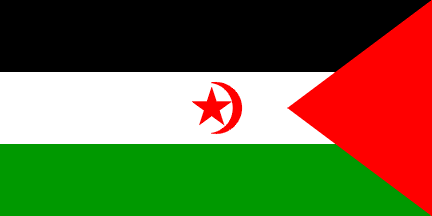
image by Željko Heimer, 01 Jan 2004 |

Last modified: 2006-07-29 by antonio martins
Keywords: western sahara | sahara | sahrawi arab democratic republic | sadr | crescent (red) | crescent: points to fly | crescent: points up | pan-arab colors | polisario front | different reverse | map | puns |
Links: FOTW homepage |
search |
disclaimer and copyright |
write us |
mirrors
 image by Željko Heimer, 01 Jan 2004 | |
* Editorial note: The Moroccan government considers Western Sahara as a part of its own territory. This page does not necessarily imply any partiality on the territorial issue in question, as also doesn’t the existence of our page about the flags of moroccan administrative divisions, among which Western Sahara is included.
Flag adopted 27 February
1976, state emblem adopted 1976,
modified June 1991.
Nozomi Kariyasu, 2001
The flag (designed by the Frente Polisario) is inverted
in nature. The black (on top) represents death, the green represents life, the
white represents peace.
Brent Overton, 24 Jan 2000
The flag of the SADR follows the pan-Arab
colours and is similar to the PLO flag [now the flag of the
Palestine Authority, ed.], with the
addition of a crescent and star on the white stripe.
Stuart Notholt, 09 Feb 1996
POLISARIO was originally closely aligned with the Algerian regime.
So it is quite likely that the SADR flag’s star and crescent
would be like that of the Algerian flag.
Stuart Notholt, 09 Feb 1996
The POLISARIO flag and the SADR flag are the same. When Polisario
proclaimed the SADR their own flag was hoisted.
Jaume Ollé, 23 Aug 1998
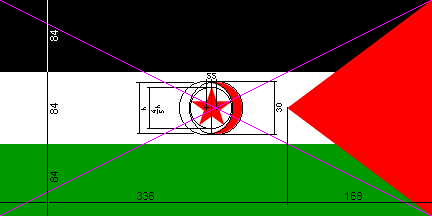 image by Željko Heimer, 01 Jan 2004 | |
The proportions are 1:2.
The height of the triangle is equal to 1/3 the length of the flag.
The centre of the circle which creates the outer arc of the crescent
is in the exact centre of the flag. The diameter of the circles which
create the outer and inner arcs of the crescent are equal to 5/7 the
width of the central stripe. The centre point of the circle
containing the star is to be found on an imaginary line connecting
the horns of the crescent, and has a diameter equal to 4/5 the
distance between the horns of the crescent. The centre points of the
circles which create the crescent and place the star are equidistant
along the horizontal meridian. (From a document issued by the Protocol
Section of the Office of the President of the Republic in June 1987.
The image above is my interpretation of the official figures for Western
Sahara, although flags in practice almost certainly don’t follow
them.)
Christopher Southworth, 01 Jan 2004
This does not quite define the distance between the two circles
determining the crescent, but from the sketches he sent me together
with the above, it seems obvious that the distance is 1/6 of the
diameter of each of the circles. (The center of the circle defining
the star is, by virtue of construction requists that it lays on the
same line as the hrons of the crescent, exactly at the midpoint
between the two circles defining the crescent.)
Željko Heimer, 01 Jan 2004
Before Spanish Sahara was a unified province
it was divided in two provinces, the Saguiat el-Hamra (the "SA"
of "polisario"… and the "EH" of the ISO
country code) and Rio de Oro (the "RIO"). The "POLI" means
"por la liberación" ("for the liberation"). Spanish
Sahara was also known as Spanish West Africa, but that one included other
bits like Ifni (to Morocco in 1969), Cape Juby (the southernmost part of
Morocco not including WS) and La Aguera.
Joàn-Francés Blanc, 16 Nov 1999
When the Spanish pulled out of this territory
in 1976, it was partitioned between Morocco, which
took the larger part, and Mauritania. Local
nationalists of the POLISARIO movement proclaimed the Sahrawi Arab Democratic
Republic on 27 February 1976.
Stuart Notholt, 09 Feb 1996
Since 1997, after internal borders changed: regional flags unknown; in Western Sahara 2 almost complete regions and part of a third:
The Polisario Flag was at first a party flag. When Spanish troops
yielded control of the country to Morroco
(Marcha verde), Polisario
proclaimed the SADR on 27 February and hoisted same flag (like
FLNA and Algeria).
At that time the SADR would be a single party country and logically the
identification between party symbol and state symbol was total. More than
half of Africa (and many others countries in the world) recognized SADR
and it was accepted in the African Union
Organization. The SADR-POLISARIO flag was very popular and no change
was ever proposed.
Jaume Ollé , 20 Nov 1999
The United Nations now seem to accept a new plan concerning the
political future of Western Sahara. Since Morocco and POLISARIO have
not been able to reach an accord on a self-determination referendum
(the problem is who is allowed to vote in this predominantly nomadic
region), UN will prefer to postpone the decision, form an autonomous
region within Morocco, and (maybe) organize the referendum in five
years.
Jan Zrzavy, 26 June 2001
From the Association de soutien à un référendum libre et régulier au Sahara Occidental (Western Sahara) newsletter:
On the eve of the anniversary of the Polisario Front, threats and intimidations against Saharawi activists increased in the occupied territories and southern Morocco, the police looking for leaflets and Saharawi flags.
An example:
20.05.03 - An emissary of the pacha of El Ayoun paid a visit to a Saharawi defender of human rights, Lidri Elhoucine, to ask him to go to the office of the pacha, which Lidri refused because there was no official summons. The same evening the pacha himself, who was following Lidri in his car, told him he knew about his “separatist” activities. The pacha threatened him with arrest if the Polisario flags, which he was accused of possessing, were distributed. Lidri is a professor of philosophy, a member of the former executive of the Forum for Truth and Justice in El Ayoun, his name figures on the list of 18 Saharawis accused in the case concerning the dissolution of the FVJ Sahara section.
Zane Whitehorn, 24 May 2003
 image by Željko Heimer, 01 Jan 2004 | |
I saw a Western Sahara flag that had the crescent and star only on [what we might at first call] the reverse. Of course this may be interpreted as:
"Obverse" means "main side" (and thus "reverse" means "secondary side"), usually the side shown in construction sheets and other flag depictions, the side where inscriptions or emblems are applied (when these are applied on one side only), the side turned outwards when the flag is arranged for indoor limp display, etc. Usually, in left to right cultures the obverse is the side with the hoist at the viewer’s left hand ("dexter hoisted"), and in right to left cultures the obverse is the side with the hoist at the viewer’s right hand ("sinister hoisted").
This being so, and considering that the flag spotted by Santiago looked like this
o________ ________o |\_______| |_______/| | )______| |__*)__( | |/_______| |_______\| | | | |then the flag is indeed sinister hoisted and has a different reverse (no emblem). The obverse is the side showing the emblem — because it shows the emblem.
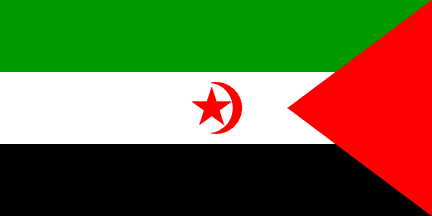 image by Željko Heimer, 01 Jan 2004 | |
When the Polisario gain independence after a referendum and are recognized
as a “true country” the green will go on top and the black will
go to the bottom.
Brent Overton, 24 Jan 2000
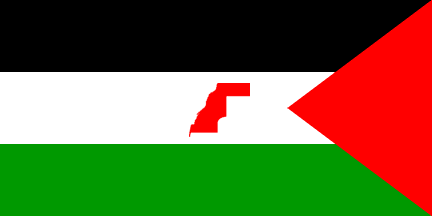 image by António Martins, 12 Jul 2004 | |
I believe the flag with a map of the Western Sahara in the center
is fictional.
Jaume Ollé, 20 Nov 1999
What was this flag? Some non-islamic Saharawi fraction or supporter
movement?
António Martins, 12 Jul 2004
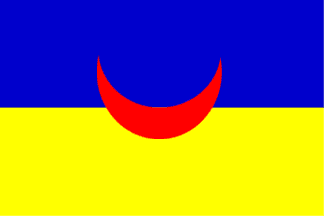
In Flaggenmitteilungen [fml],
December, 10, 1975, on p.2, is a flag of the PUNS. The PUNS is Parti
de l’Union National Sahraoui
(General Secretary Mr.Khali Hana Ould Rachid, the President of Municipal
Council d’El Ayoune), created in 1975 by pro-spanish politics in
Spanish Western Sahara. Obviously (it is similar
that) this flag of the PUNS was a derivative from a flag (guidon)
of the Ifni-Sahara Maritime Province.
Mikhail Revnivtsev, 07 Nov 2005
Anything below this line was not added by the editor of this page.